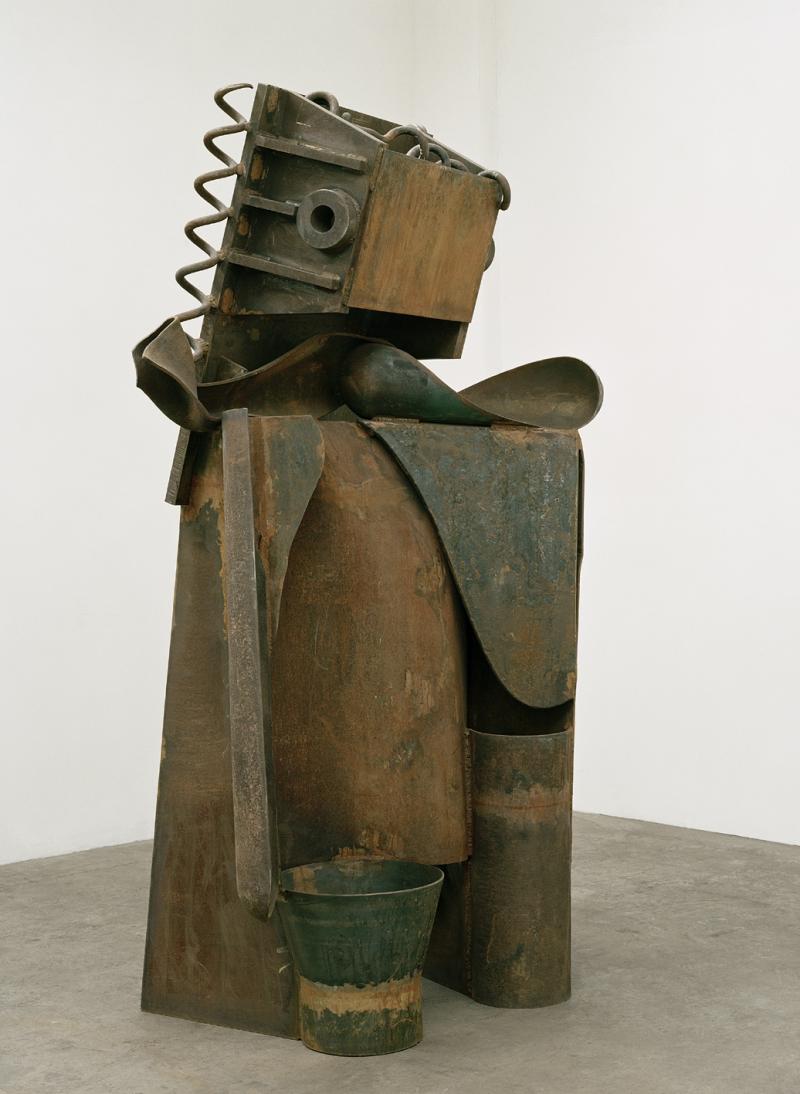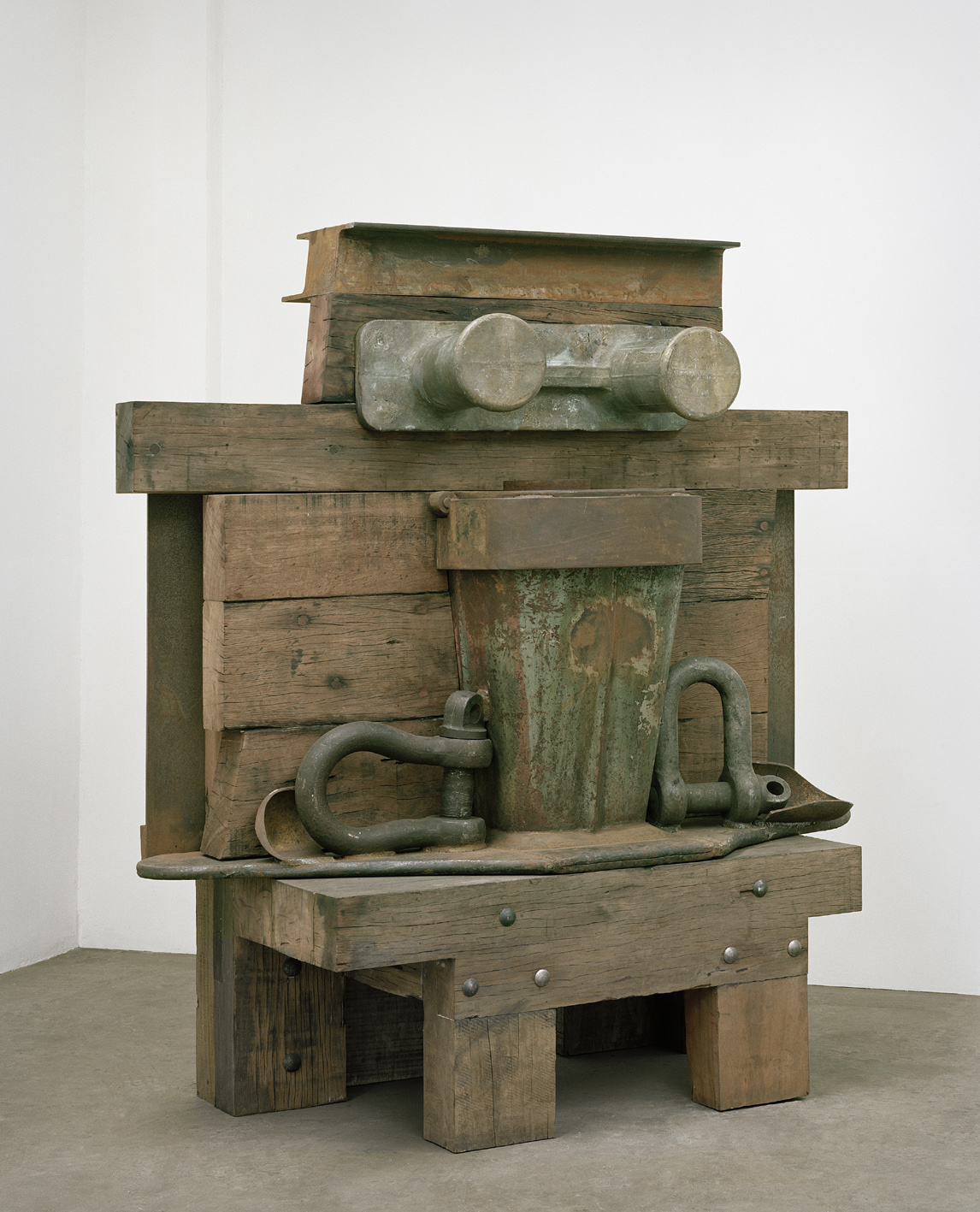Anthony Caro: Upright Sculptures, Annely Juda | reviews, news & interviews
Anthony Caro: Upright Sculptures, Annely Juda
Anthony Caro: Upright Sculptures, Annely Juda
The venerated sculptor enjoys the interplay between the figurative and the abstract

Anthony Caro makes works with the human figure in mind. The venerated sculptor, who, at 86, remains seemingly unstoppable, came to prominence in the early Sixties with his brightly coloured abstract steel sculptures. These, such as his seminal 1962 work, Early One Morning – an open-form sculpture of welded steel plates and delicately balancing rods painted in bright red – chimed with an era of optimism and confidence. Any figurative references were entirely incidental.
A different Caro emerged in the Eighties when he produced monumental works of solid mass and volume. Rich with references to mythology, these later works were not only concerned with the interplay between architecture and sculpture, but between the figurative and the abstract.
His new body of work, produced in the past 18 months, is simply called Upright Sculptures, and they look like a cross between defunct farming equipment and mock-sinister, bug-eyed sentinels. Welded or bolted together, they consist of materials such as rusty steel, rusticated wood and pieces of industrial scrap.
These Uprights include the gently comical Goddess (main picture), a rusty fusion of industrial  parts whose huge blank eyes stare out from the sides of a flat, boxy head sweetly framed by ringlets of metal, and Head (pictured right), a squat structure built from planks of wood, with a bucket that could pass for a huge, bulbous nose, and protruding metal, antennae eyes. They seem to be dumb but watchful creatures; largely benign yet with the characteristics of an unpredictable robot.
parts whose huge blank eyes stare out from the sides of a flat, boxy head sweetly framed by ringlets of metal, and Head (pictured right), a squat structure built from planks of wood, with a bucket that could pass for a huge, bulbous nose, and protruding metal, antennae eyes. They seem to be dumb but watchful creatures; largely benign yet with the characteristics of an unpredictable robot.
They are all more or less of human dimensions and play with the aesthetics of old-fashioned Cubism. Up the Ante, for example, consists of a series of flat, interlocking planes of rusted steel topped with a hooded structure the size of a head and situated at head height. Many of their titles suggest their vertical forms, Drum Up, Up North, Three Up and Upper Field.
But though their titles might suggest that all is upbeat and jaunty, these are not works that sing in the bright colours of the coming of a new modernist dawn, as his earlier work once did, but hark back to a kind of defunct modernity. And this is in some ways a little more interesting.
These Upright Sculptures are undoubtedly influenced by The Chapel of Light, Caro’s ambitious, decade-long project for the Church of Saint-Jean-Baptiste, in Bourbourg, northern France, which was unveiled in 2008. Ragged strips of rumpled steel, wood and terracotta figures were installed within the church’s Gothic arches, producing a powerful and compelling dialogue between the Gothic and the Modern. They each represented conflicting utopias, one religious, the other quasi-religious, with neither one particularly certain of itself any more.
In a way, Caro’s Upright Sculptures - playful, heavy, robotic, human – capture the mood of a similar kind of uncertainty. And that, too, plays perfectly to our times – though one doesn’t necessarily feel that this is at all intentional.
- Anthony Caro: Upright Sculptures is at Annely Juda until 2 July
The future of Arts Journalism
You can stop theartsdesk.com closing!
We urgently need financing to survive. Our fundraising drive has thus far raised £49,000 but we need to reach £100,000 or we will be forced to close. Please contribute here: https://gofund.me/c3f6033d
And if you can forward this information to anyone who might assist, we’d be grateful.

Subscribe to theartsdesk.com
Thank you for continuing to read our work on theartsdesk.com. For unlimited access to every article in its entirety, including our archive of more than 15,000 pieces, we're asking for £5 per month or £40 per year. We feel it's a very good deal, and hope you do too.
To take a subscription now simply click here.
And if you're looking for that extra gift for a friend or family member, why not treat them to a theartsdesk.com gift subscription?
more Visual arts
 'We are bowled over!' Thank you for your messages of love and support
Much-appreciated words of commendation from readers and the cultural community
'We are bowled over!' Thank you for your messages of love and support
Much-appreciated words of commendation from readers and the cultural community
 Folkestone Triennial 2025 - landscape, seascape, art lovers' escape
Locally rooted festival brings home many but not all global concerns
Folkestone Triennial 2025 - landscape, seascape, art lovers' escape
Locally rooted festival brings home many but not all global concerns
 Sir Brian Clarke (1953-2025) - a personal tribute
Remembering an artist with a gift for the transcendent
Sir Brian Clarke (1953-2025) - a personal tribute
Remembering an artist with a gift for the transcendent
 Emily Kam Kngwarray, Tate Modern review - glimpses of another world
Pictures that are an affirmation of belonging
Emily Kam Kngwarray, Tate Modern review - glimpses of another world
Pictures that are an affirmation of belonging
 Kiefer / Van Gogh, Royal Academy review - a pairing of opposites
Small scale intensity meets large scale melodrama
Kiefer / Van Gogh, Royal Academy review - a pairing of opposites
Small scale intensity meets large scale melodrama
 Jenny Saville: The Anatomy of Painting, National Portrait Gallery review - a protégé losing her way
A brilliant painter in search of a worthwhile subject
Jenny Saville: The Anatomy of Painting, National Portrait Gallery review - a protégé losing her way
A brilliant painter in search of a worthwhile subject
 Abstract Erotic, Courtauld Gallery review - sculpture that is sensuous, funny and subversive
Testing the boundaries of good taste, and winning
Abstract Erotic, Courtauld Gallery review - sculpture that is sensuous, funny and subversive
Testing the boundaries of good taste, and winning
 Edward Burra, Tate Britain review - watercolour made mainstream
Social satire with a nasty bite
Edward Burra, Tate Britain review - watercolour made mainstream
Social satire with a nasty bite
 Ithell Colquhoun, Tate Britain review - revelations of a weird and wonderful world
Emanations from the unconscious
Ithell Colquhoun, Tate Britain review - revelations of a weird and wonderful world
Emanations from the unconscious
 Rachel Jones: Gated Canyons, Dulwich Picture Gallery review - teeth with a real bite
Mouths have never looked so good
Rachel Jones: Gated Canyons, Dulwich Picture Gallery review - teeth with a real bite
Mouths have never looked so good
 Yoshitomo Nara, Hayward Gallery review - sickeningly cute kids
How to make millions out of kitsch
Yoshitomo Nara, Hayward Gallery review - sickeningly cute kids
How to make millions out of kitsch
 Hamad Butt: Apprehensions, Whitechapel Gallery review - cool, calm and potentially lethal
The YBA who didn’t have time to become a household name
Hamad Butt: Apprehensions, Whitechapel Gallery review - cool, calm and potentially lethal
The YBA who didn’t have time to become a household name

Add comment